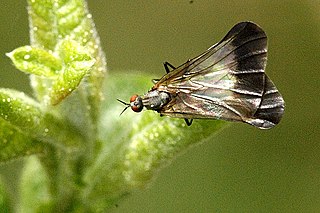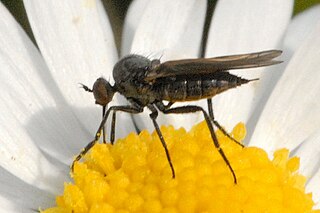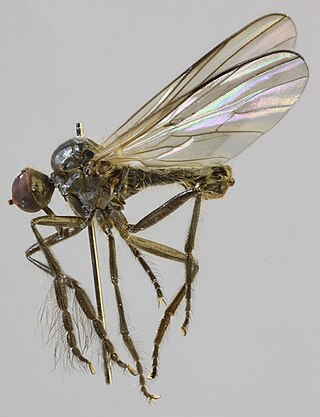
Empididae is a family of flies with over 3,000 described species occurring worldwide in all the biogeographic realms but the majority are found in the Holarctic. They are mainly predatory flies like most of their relatives in the Empidoidea, and exhibit a wide range of forms but are generally small to medium-sized, non-metallic and rather bristly.

Rhamphomyia is a genus of dance flies, in the fly family Empididae. It contains more than 600 species in 8 subgenera.

Rhamphomyia sulcata is a species of dance flies, in the fly family Empididae. It is included in the subgenus Rhamphomyia. It is found in most of Europe, except the Balkan Peninsula.

Rhamphomyia marginata is a species of dance flies, in the fly family Empididae. It is found in Europe, from Great Britain east to Romania and from Fennoscandia south to France, Austria and Hungary.

Rhamphomyia crassirostris is a species of dance flies, in the fly family Empididae. It is found in most of Europe, east to Poland and Hungary. It is absent from Italy and the Balkan Peninsula.

Rhamphomyia flava is a species of dance flies, in the fly family Empididae. It is found in most of Europe, except the Iberian Peninsula and most of the Balkan Peninsula.

Rhamphomyia pilifer is a species of dance flies, in the fly family Empididae. It is found in most of Europe, except the Balkan Peninsula and the Iberian Peninsula.

Rhamphomyia simplex is a species of dance flies, in the fly family Empididae. It has a limited distribution. It is known from Ireland, east to Germany and from Sweden, Finland and north-west Russia.

Rhamphomyia umbripennis is a species of dance flies, in the fly family Empididae. It is included in the subgenus Holoclera of the genus Rhamphomyia. It is found in most of Europe, from Ireland east to Slovakia and from Fennoscandia south to Italy. In the northern part of the range it is found from Norway to central Russia.

Empidinae, also called dance flies, are a subfamily of empidoid flies. They are mainly predatory flies like most of their relatives, and generally small to medium-sized. Most species are flower visitors and they can be effective pollinators.

Rhamphomyia hirsutipes is a species of fly in the family Empididae. It is include in the subgenus Amydroneura of the genus Rhamphomyia. It is found in the Palearctic.

Rhamphomyia stigmosa is a species of fly in the family Empididae. It is found in the Palearctic.
Rhamphomyia sudigeronis is a species of dance flies.

Rhamphomyia longicauda, the long-tailed dance fly, is a species of fly commonly found in eastern North America that belongs to the family Empididae and part of the superfamily of dance flies Empidoidea. It is included in the subgenus Rhamphomyia. This species of fly is most known for sex role reversal during courtship, as females put on exaggerated displays and congregate in leks to attract males. Females cannot hunt for food, so they receive protein from nuptial gifts brought to them by males. Female dependence on males for nutrition is the principal cause for sex role reversal in this species of fly.
Rhamphomyia brevis is a species of dance flies.
Rhamphomyia nana is a species of dance flies.
Rhamphomyia cervi is a species of dance flies, in the fly family Empididae. It is included in the subgenus Lundstroemiella.
Rhamphomyia cimrmani is a species of dance flies, in the fly family Empididae. It is included in the subgenus Lundstroemiella.
Rhamphomyia speighti is a species of dance flies, in the fly family Empididae. It is included in the subgenus Lundstroemiella.
Rhamphomyia strobli is a species of dance flies, in the fly family Empididae. It is included in the subgenus Lundstroemiella.










